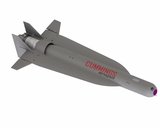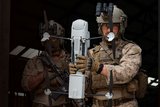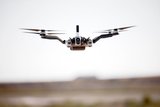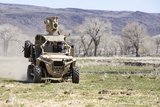InterSense delivers next-generation 'NavChip' IMU technology
To support the rapidly growing MEMS IMU (inertial measurement unit) market, InterSense Incorporated today announced the commercial availability of NavChip, the world's first IMU on a chip.
NavChip can be integrated into small, unmanned vehicles such as UAVs and robots to assist with autonomous navigation and stabilization. It also allows for the miniaturization of camera and antenna stabilization systems in both fixed and mobile applications. Enabling advanced inertial navigation applications, including GPS/INS integration previously limited to higher-end systems, NavChip is a high performance, low-cost enabling sensor technology that is available in the smallest possible form factor.
NavChip has been successfully tested and targeted to support a variety of industries, from the military to first responders, in four key areas: personnel navigation, GPS/INS, stabilization and visualization.
- Personnel navigation: The low drift and low noise of the NavChip enables accurate tracking of an individual's location over extended periods of time and distance when GPS is unavailable such as inside buildings and urban canyons, for example. Applications include using NavChip to track dismounted soldiers, firefighters, and first responders where it can be critical to pinpoint "downed" personnel in emergency situations.
- GPS/INS: NavChip's size and form factor make it an ideal fit for a tightly fused GPS/INS solution to support autonomous navigation in small vehicles like UAVs and robots. The low power consumption and superior performance of the sensor also assist in accurately guiding an unmanned system for extended periods of time.
- Stabilization: NavChip also enables stabilization of small, light-weight sensors, which are critical for many business and military operations, especially those requiring photographs or video imaging. InterSense is working with several gimbal manufacturers to embed NavChip in cameras and payloads supporting applications from aerial surveillance to homeland security.
- Visualization: The light weight, small size and low drift of NavChip make it key component for Head-Mounted Display (HMD) applications, bringing real-time visualization to a broader range of industrial and military applications, including simulation and training exercises.
"For the military and most commercial markets, technology is the key to gaining and maintaining advantage," said TC Browne, president & CEO, InterSense Inc. "NavChip is their new force multiplier. By delivering the power of a traditional IMU with smaller size and weight, lower cost and better performance, NavChip gives system integrators and manufacturers the tool they need to create new applications, innovate across multiple markets, and grow their business."
As system integrators look to embed sensors directly into their platforms, the demand for smaller and better performing IMU's is increasing. NavChip was designed to support these expanding requirements by offering a 12-fold improvement in noise and a two-fold improvement in drift compared to previous commercial-grade IMUs in this class. The small size and low power consumption also deliver a major advantage as the sensor can be mounted directly onto a PCB, thereby minimizing use of valuable real estate and enabling seamless integration.
InterSense is now taking orders for initial production NavChip units, slated for delivery in September 2011. NavChip will be available for integration into an OEM board design or with a full OEM Developers Kit. For more information or to see the NavChip in action, stop by InterSense's booth, #3100, at AUVSI's Unmanned Systems North America conference, Walter E. Washington Convention Center, Washington DC.
Source: InterSense
More from Uncrewed Vehicles
-
![Cummings Aerospace showcases Hellhound loitering munition designed for US Army’s LASSO programme (video)]()
Cummings Aerospace showcases Hellhound loitering munition designed for US Army’s LASSO programme (video)
Cummings Aerospace presented its turbojet-powered Hellhound loitering munition at SOF Week 2025, offering a man-portable solution aligned with the US Army’s LASSO requirements.
-
![SOF Week 2025: PDW unveils attritable FPV drone for SOF operations at scale]()
SOF Week 2025: PDW unveils attritable FPV drone for SOF operations at scale
PDW has revealed its Attritable Multirotor First Person View drone at SOF Week 2025, offering special operations forces a low-cost, rapidly deployable platform for strike and ISR missions, inspired by battlefield lessons from Ukraine.
-
![SOF Week 2025: Teledyne FLIR white paper provides guidance on reusable loitering munitions]()
SOF Week 2025: Teledyne FLIR white paper provides guidance on reusable loitering munitions
Teledyne FLIR is highlighting the emerging requirements for 'recoverable and re-usable' loitering munitions across the contemporary operating environment during this week’s SOF Week conference in Tampa, Florida.
-
![SOF Week 2025: Kraken Technology group debuts K3 Scout USV in North America]()
SOF Week 2025: Kraken Technology group debuts K3 Scout USV in North America
High-performance maritime industry player Kraken Technology Group, based in the UK, has used the SOF Week conference in Tampa, Florida this week to debut its K3 Scout uncrewed surface vessel (USV) to the North American market.
-
![Palladyne AI and Red Cat to demonstrate capabilities for autonomous drone swarms to the US military]()
Palladyne AI and Red Cat to demonstrate capabilities for autonomous drone swarms to the US military
Red Cat and Palladyne AI recently conducted a cross-platform collaborative flight involving three diverse heterogeneous drones.
-
Jammer resistant drone designs spark search for countermeasures
The Russia-Ukraine conflict has driven another stage of evolution for drones and the counter measures to defend against them.

























